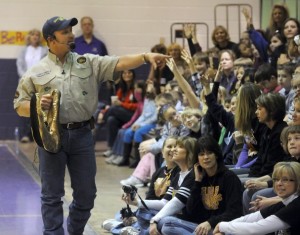Mistake #1. Opening weakly
Solution: Get attention! Invite the audience in immediately with a startling statement or image, a communal action (singing, chanting, clapping in rhythm) – anything that commands attention and shows the kids that the program is in your capable hands.
 Mistake #2. Being unaware of audience reaction
Mistake #2. Being unaware of audience reaction
Solution: Learn to “read” the room. Are kids getting restless? Beginning to chat? Turning away from your presentation? Time to switch up the content or pace and get them refocused.
Mistake #3. Speaking too softly, quickly or monotonously
Solution: Practice breathing, projecting, slowing the pace and speaking with lots of expression. Even if you think you have a voice like a foghorn, it will sound strained to those in the back of the multipurpose room. Be sure to use a microphone. And don’t talk to the screen or easel – face your audience.
Mistake #4. Using visuals or props that are hard to see
Solution: Aim for the kids in the back of the room. Make props oversize. Be sure everyone has a clear view of your props and the screen
Mistake #5: Going overtime
Solution: Appoint a timekeeper to give you warnings at 10 minutes, 5 minutes and the end. Keep your eye on the clock so that you can adjust your pacing.
Mistake #6. Failing to create an ending with impact or with a call to action
Solution: If you like to incorporate a Q & A into your assembly, don’t end with it – place it just before the ending. Wrap up by sending the group out with one last anecdote, a summary of the points you made in your presentation or an appeal for them to do something (Be sure to read! Write! Start a book club!)

Excellent as usual!
Thanks, Gwendolyn. I think we’ve all made these mistakes at various times over the years. it’s nice to know they’re not fatal!
Thanks for the great tips! I need to get my author visit content outlined, so this is timely!
Regarding #1, After an opening sentence or two, (“I’m excited to be here… etc.”) I have that found opening with a question gets me off to a good start. Hands go up immediately, even among the older, possibly more reticent 5ths & 6ths. The same question works with all ages, but, of course, elicits different answers, depending on age. In fact, at this point, I can predict which answers I’ll get from which grades.
Regardless of their ages and replies, I can then give them MY answer to that question, which is seldom given by anyone in the assembly, regardless of age. This leads me back to the first main point I want to make, and then I’m off… with an engaged audience (I hope!) along for the ride.
What’s the question? That’s my little trade secret!
😉
Kim
ps — Questions are always a good way to energize and engage the crowd. Doesn’t have to be my big starter question. Could be simply stopping, mid-sentence, and asking for the definition of a word you just used, “What’s a verb?” “Who can give me an example of an adjective?” or “Can you guess how many times I revised this story?” etc.
Great tips, Alexis! Mistake #6 is TOO familiar…I should re-read this list the night before each of my school visits!!
Love these tips. For the timekeeper, I use the timer app on my phone. I have it chime 5 minutes before time is up. It signals a clear end to the Q&A, and gives me a couple of minutes to wrap it up with one last poem and a closing comment.
Perfect, Genevieve! I especially like that you leave time at the end to do a wrap-up. So many authors, when they do Q & As, end with something like, “Well, I guess we’re all out of time” and then there’s chaos as the kids scramble to their feet. Your technique leaves them with your last words of encouragement ringing in their ears as they walk back to their classrooms.